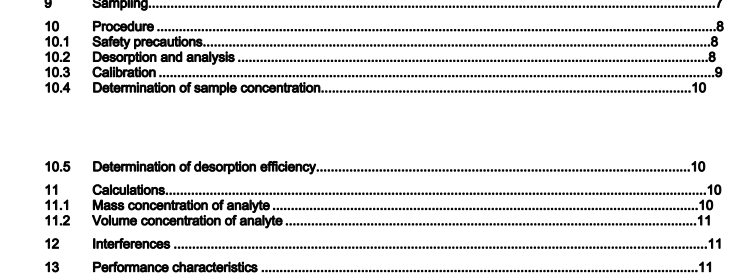BS EN ISO 16017-1:2001 – Indoor, ambient and workplace air — Sampling and analysis of volatile organic compounds by sorbent tube/thermal desorption/capillary gas chromatography — Part 1: Pumped sampling

The following normative documents contain provisions which, through reference in this text, constitute provisions of this part of ISO 16017. For dated references, subsequent amendments to, or revisions of, any of these publications do not apply. However, parties to agreements based on this part of ISO 16017 are encouraged to investigate the possibility of applying the most recent editions of the normative documents indicated below. For undated references, the latest edition of the normative document referred to applies. Members of ISO and IEC maintain registers of currently valid International Standards.
3 Terms and definitions
For the purposes of this part of ISO 16017, the following terms and definitions apply.
3.1
breakthrough volume
volume of test atmosphere that can be passed through a sorbent tube before the concentration of eluting vapour reaches 5 % of the applied test concentration
NOTE 1 The breakthrough volume varies with the vapour and the sorbent type.
NOTE 2 See reference [4]. 3.2
retention volume
elution volume at peak maximum of a small aliquot of an organic vapour eluted from a sorbent tube by air or chromatographic carrier gas
4 Principle A measured volume of sample air is drawn through one (or more) sorbent tubes in series; an appropriate sorbent (or sorbents) being selected for the compound or mixture to be sampled. Provided suitable sorbents are chosen, volatile organic components are retained by the sorbent tube and thus are removed from the flowing air stream. The collected vapour (on each tube) is desorbed by heat and is transferred under inert carrier gas into a gas chromatograph equipped with a capillary column and a flame ionization detector or other suitable detector, where it is analysed. Analytical calibration is achieved by means of liquid or vapour spiking onto a sorbent tube.
5 Reagents and materials
During the analysis, use only reagents of recognized analytical reagent grade.
Fresh standard calibration blend solutions should be prepared weekly, or more frequently if evidence is noted of deterioration, e.g. condensation reactions between alcohols and ketones.
5.1 Volatile organic compounds, for calibration purposes, using either liquid spiking (5.7 and 5.8) or vapour spiking (5.4 to 5.6) onto sorbent tubes.
5.2 Dilution solvent, for preparing calibration blend solution for liquid spiking (5.7). This should be of chromatographic quality. It shall be free from compounds co-eluting with the compound or compounds of interest (5.1).
NOTE Methanol is frequently used. Alternative dilution solvents e.g. ethyl acetate or cyclohexane, can be used, particularly if there is no possibility of reaction or chromatographic co-elution .
BS EN ISO 16017-1:2001 – Indoor, ambient and workplace air — Sampling and analysis of volatile organic compounds by sorbent tube/thermal desorption/capillary gas chromatography — Part 1: Pumped sampling